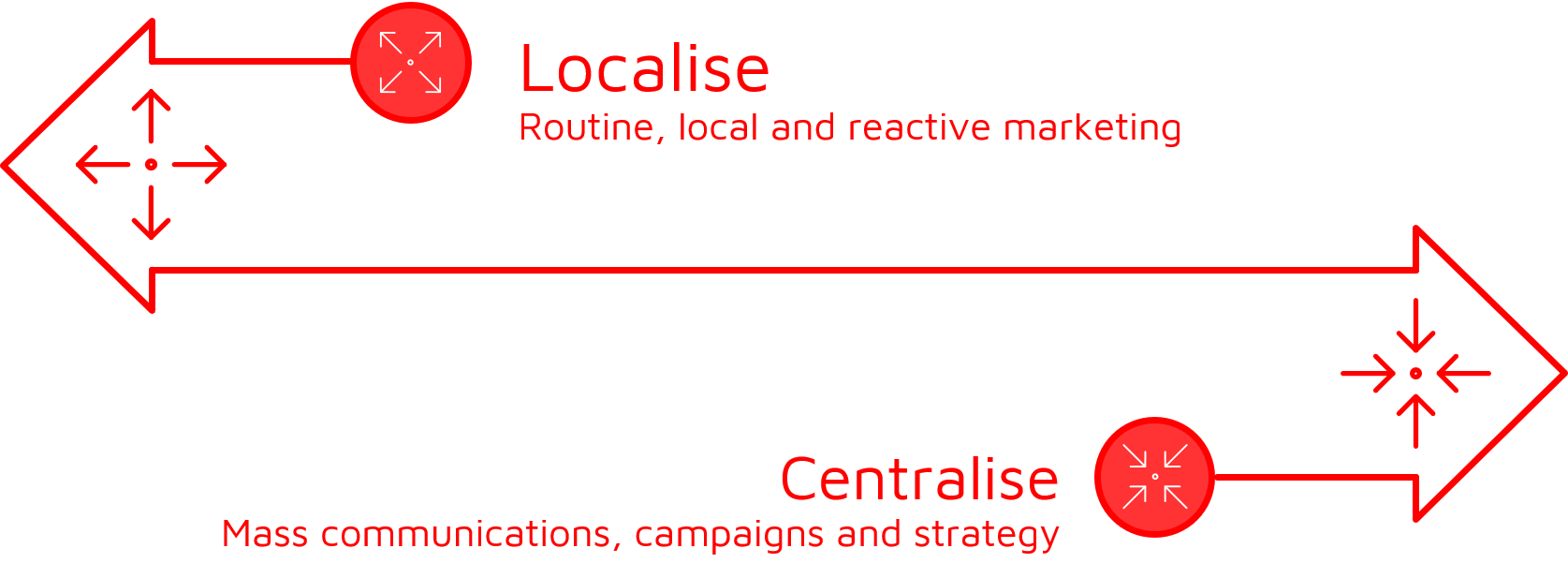In the world of marketing, one size does not fit all. Different markets require different messaging to capitalise on individual opportunities and reflect regional sensitivities. Managing local marketing in this way can be challenging, but the rewards for getting it right – and the cost of getting it wrong – mean it’s worth making the effort to deliver a more tailored local approach.
Think global, act local
You may have heard the mantra ‘think global, act local’ in a marketing context. This philosophy, applied via ‘glocalisation’, refers to adapting a universal message to appeal to local markets.
The approach is also valid at the national–regional level. Just as individual country markets have unique characteristics, at a smaller scale so do individual regions, cities or towns. Customer priorities, and consequently the best marketing approach, vary greatly from place to place.
The perils of getting your messaging wrong
When an organisation fails to adapt its messaging to local communities, the results can be disastrous. Marketing that falls wide of the mark can alienate potential customers and do serious damage to your brand. Properly managing local marketing will prevent this.
Infamous examples of local marketing gone wrong include KFC’s hilariously misjudged attempt to enter China in the 1980s. Its efforts to translate its famous ‘Finger-lickin’ good’ slogan to Mandarin resulted in the far less appealing ‘Eat your fingers off’. Not the sentiment they were aiming for.
Car manufacturer Ford got things similarly wrong when it sought to promote its models to the Belgian market. A mistranslation of ‘Every car comes with a high-quality body’ resulted in ‘Every car comes with a high-quality corpse’ – a message unlikely to win over many customers.

Of course, these errors occurred due to a language barrier, and in most cases no such barrier exists between different regions within a single national market. But the same principles apply when managing local marketing: know your markets, and adjust your message accordingly.
Fully centralised marketing: impersonal and inflexible
Despite the benefits of localisation, there are valid reasons for an organisation to control all its marketing centrally. Perhaps the most obvious is the economy of scale: a central team distributing marketing messaging and materials to regional offices or shops can pay for all design and production costs at once.
The team is also likely to be made up of experienced professional marketers. Managing local marketing with a team of the same calibre distributed around a national network would likely require significantly higher staff costs.
The other big benefit is control. A central team can ensure that all marketing hits the right message, meets all necessary compliance criteria and conforms to brand guidelines. There is no risk of miscommunication.
But central marketing cannot react to individual, local conditions. If a competitor in a single town goes out of business, or offers a discount, or even just closes unexpectedly for a day, a single, inflexible central message is unable to respond.
Fully localised marketing: inconsistent and uncompliant
If marketing is taken care of at a local level, that team can respond quickly to changes in their market. And staff operating – and often living – within that market know their customers far better than a central team ever can, as well as being sensitive to local culture, events and other opportunities.
However, managing local marketing without central oversight can lead to a compliance nightmare. Suddenly your brand values are forgotten as different locations each strike a different tone, ignore brand guidelines and put their own spin on your messaging. Your brand identity is destroyed.
Sure, local teams know how to connect with their customers. But if that connection comes at the cost of your brand, is it worth it?
Central marketing vs local marketing: a question of balance
The truth is that central marketing and local marketing both have a role to play in attracting customers. A central marketing team, often working from an organisation’s head office, is best placed to take care of the broad strokes of marketing: aspects such as an organisation’s mission, brand identity and values. On the other hand, the finer detail – the more nuanced messaging designed to drive individual sales – is better looked after by local teams or individuals.
As an example, take a car manufacturer. The manufacturer determines its selling points centrally: the image it wishes its cars to project; whether it focuses on speed, practicality or value; the story behind the marque. Central marketing is designed to attract customers to the brand.
But that manufacturer also depends upon a network of dealerships. And the marketing efforts of the dealerships have a different aim: to get customers into the showroom. Managing local marketing in this way might involve promoting individual prices, stock levels, repair services or other deals – perhaps in response to what competitors in the local area are offering. This nitty-gritty marketing work is far better handled at a local level.
Managing local marketing, the optimal way
What organisations with a distributed network need is a way to combine the control and economies of scale of centralised marketing with the market knowledge and responsiveness of a localised approach. Managing local marketing using this method represents the best of both worlds.
ROI360 is a marketing toolkit designed to meet this exact need: to bridge the gap between central and localised marketing. It combines powerful and flexible artwork creation software with detailed budgeting and approval processes, audit trails and analytics.

Central marketing can lock down elements of artwork that represent the brand identity, ensuring the core messaging and positioning remains unchanged across markets. Local teams can then customise and produce the artwork to meet local needs, reacting to local circumstances and using materials that connect with their customers.
Managing local marketing like this allows local teams to add supplementary selling points that reflect their market’s needs, without compromising elements such as a tagline, logos, fonts and colours.
A virtuous circle: increased local ownership and investment
Giving local teams increased control over their marketing will result in those teams becoming more invested in their own success. Local marketers will no longer feel the need to ‘reinvent the wheel’ when your central marketing message does not fit with their local needs.
Increased investment will lead to increased ownership, and so on. Managing local marketing in this way puts power in the hands of local teams without compromising central control, and frees up the central team to concentrate on more strategic marketing projects.
Every customer exists in a local market. The more flexible your marketing, the better. Your local teams, dealers and salespeople who operate within each market are the people who best understand that market. ROI360 gives your local teams the power to exploit that understanding without compromising your brand’s message and positioning.
Discover your Marketing Portal Suitability Score
ROI360 is transformative marketing software with many applications. If you want to know if your business model would benefit from this hybrid approach to managing local marketing, take our quick quiz to get your Marketing Portal Suitability Score.
You can also start a free demo of ROI360 to explore our software for yourself.




